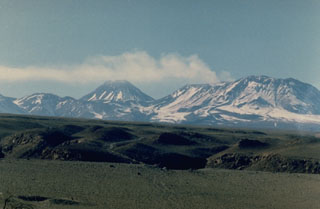Report on Lascar (Chile) — 12 February-18 February 2025
Smithsonian Institution / US Geological Survey
Weekly Volcanic Activity Report, 12 February-18 February 2025
Managing Editor: Sally Sennert.
Please cite this report as:
Global Volcanism Program, 2025. Report on Lascar (Chile) (Sennert, S, ed.). Weekly Volcanic Activity Report, 12 February-18 February 2025. Smithsonian Institution and US Geological Survey.
Lascar
Chile
23.37°S, 67.73°W; summit elev. 5592 m
All times are local (unless otherwise noted)
On 6 February the Servicio Nacional de Geología y Minería (SERNAGEOMIN) issued a special report noting increased emissions at Láscar. A whitish-colored gas plume observed in webcam views rose almost 2 km above the summit. Sulfur dioxide emissions detected in satellite data were 188 tons per day which was characterized as atypical during the previous year. A thermal anomaly in the crater was identified in satellite data suggesting an increase in temperature within the crater. Seismicity did not clearly indicate variations that may be related to unrest, though two long-period earthquakes were recorded on 7 and 9 February. Sulfur dioxide emissions increased to 752 tons on 11 February. On 12 February the Alert Level was raised to Yellow (the second lowest level on a four-color scale) and the public was warned to stay at least 1 km away from the crater.
Geological Summary. Láscar is the most active volcano of the northern Chilean Andes. The andesitic-to-dacitic stratovolcano contains six overlapping summit craters. Prominent lava flows descend its NW flanks. An older, higher stratovolcano 5 km E, Volcán Aguas Calientes, displays a well-developed summit crater and a probable Holocene lava flow near its summit (de Silva and Francis, 1991). Láscar consists of two major edifices; activity began at the eastern volcano and then shifted to the western cone. The largest eruption took place about 26,500 years ago, and following the eruption of the Tumbres scoria flow about 9000 years ago, activity shifted back to the eastern edifice, where three overlapping craters were formed. Frequent small-to-moderate explosive eruptions have been recorded since the mid-19th century, along with periodic larger eruptions that produced ashfall hundreds of kilometers away. The largest historical eruption took place in 1993, producing pyroclastic flows to 8.5 km NW of the summit and ashfall in Buenos Aires.
Source: Servicio Nacional de Geología y Minería (SERNAGEOMIN)

